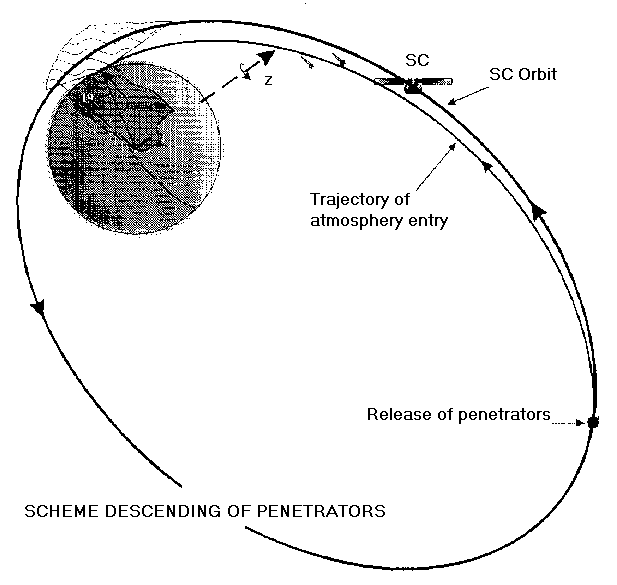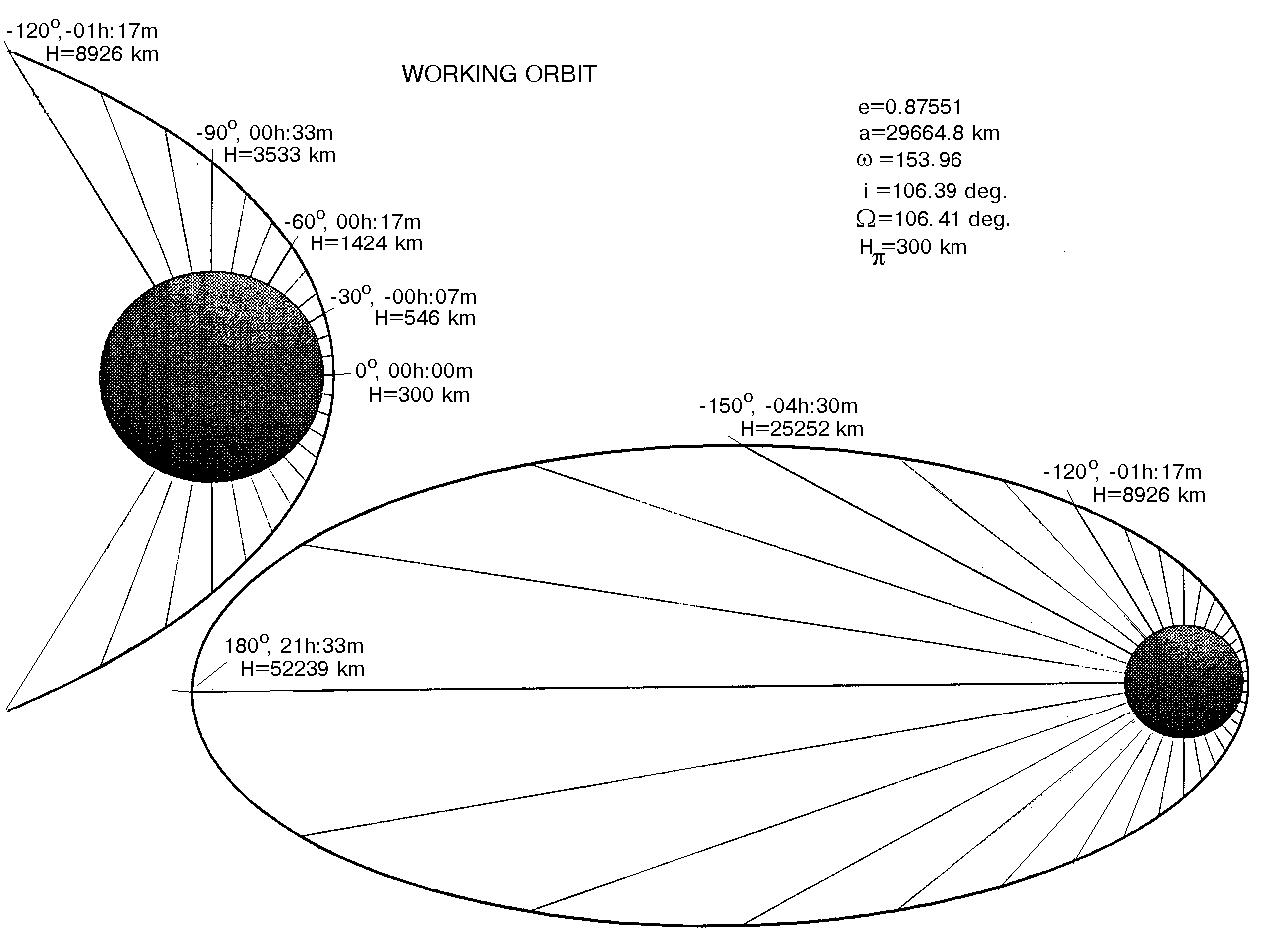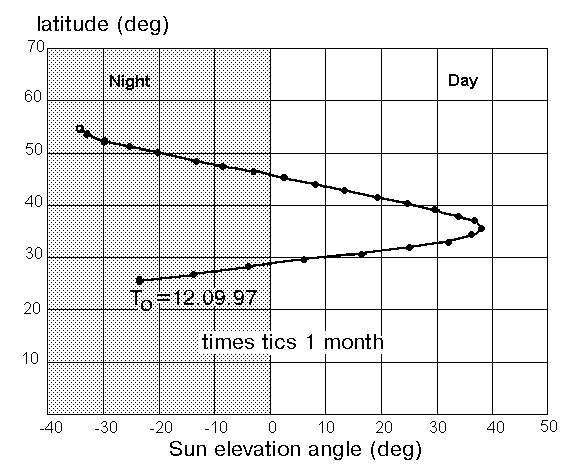| ROBOTIC SPACECRAFT MISSION TO MARS. Brief description |

|
MISSION SCENARIO CONTENTS
The mission design contains the following main phases:
MARS-96 will be launched on November 16, 1996 from the Baikonur cosmodrome. Four stages of the PROTON LV and the S/C propulsion unit will be used to inject to the Mars transfer trajectory. During ascent, the first 3 stages of the PROTON LV will burn to completion and separate. The initial ignition of the fourth stage will inject the S/C into a near circular parking orbit having the following parameters:altitude 165 km, inclination 51.6 deg. At the end of the first revolution, the fourth stage will be ignited again and will accelerate the S/C to a speed slightly less than necessary to achieve the Mars transfer trajectory. The fourth stage will then separate and the S/C propulsion unit will be used for final injection to the Mars transfer trajectory.The payload fairing is jettisoning at 185 sec into the flight. The mass of the space stage at this moment is 24691 kg. 
The deployment of the high and medium gain antennae are after fourth stage separation and before the initial S/C propulsion unit burn. The solar arrays and the platform PAIS with its science payload will be deployed after achieving the Mars transfer trajectory. The initial burn of the PROTON LV fourth stage provides a delta-V about 363 m/s. For injection to Mars from the parking orbit, it is necessary to add an additional delta-V of 3725 m/s: 3150 m/s from burn to completion of the fourth stage; and 575 m/s from the S/C propulsion unit. The control system of the S/C will autonomously adjust the attitude and delta-V parameters of the final injection maneuver as result of flight navigation calculations. EARTH-MARS TRANSFER ORBITIn the beginning of the chapterA type 2 interplanetary trajectory will be used having a heliocentric angular distance of travel greater than 180 deg for the MARS-96 S/C to reach Mars. The launch is scheduled on November 16, 1996, with arrival at Mars on 12 September 1997. Transfer time is about 10 months. Two midcourse corrections are scheduled during interplanetary cruise: the first correction will be 7-10 days after launch; the second will be one month before arrival to Mars. Total delta-V for these corrections will be less than 35 m/s. 
A small deflection maneuver will be performed after the release of the SS, about 4-5 days before arrival. The corrections will be based on range and range rate tracking of the spacecraft from Ussurijsk and Evpatoria plus VLBI measurements provided by the US DSN stations. Radar localization of the terrestrial planets is also scheduled during the flight for adjustment of the planetary ephemerides. The time of arrival at Mars is constrained by the desire to target the SS to pre-selected landing areas. Dispersion of the SS landings will not exceed ±550 km (in plane) and ±7 minutes in time. At the moment of SS release, the knowledge accuracy of the S/C position will be better than ±150 km in position and ±1 minutes in time. LANDING OF SMALL STATIONS AND ORBITER DEFLECTION MANEUVERIn the beginning of the chapterFive days before arrival to Mars, the two SS will be jettisoned and the Orbiter will be deflected to the trajectory needed for braking into the initial Mars orbit. Release of the SS is also possible at 4 days before arrival as backup. The deflection maneuver will be performed just after ejection of the SS and will be based upon the latest radiometric orbit determination data. The Delta-V for this maneuver will be less than 35 m/s.All SS candidate landing sites are situated in the Northern Mars hemisphere (ARCADIA Planitia) with landings occurring in daylight.
Ejection of each SS will use a special pneumatic mechanism. No gas will escape to outer space, avoiding additional trajectory perturbations. The angle of atmospheric entry of the SS will be in the range 10.5 - 20.5 degrees. The descent path distance to the Martian surface will range from 550 - 250 km, respectively. Nominal values of the entry angle and path length are 16.5 deg and 315 km. Entry speed will be less than 5.75 km/s, ignoring atmospheric winds. All SS candidate landing sites are situated in the Northern Mars hemisphere (ARCADIA Planitia) with landings occurring in daylight. The SS landings and the Orbiter braking maneuver timings were designed to that these activities will be visible from the ground tracking stations at Ussurijsk and Evpatoria. Possible deviation of the SS landing points from nominal will not exceed ±10 deg along track and ±2 deg cross track. The azimuth of the SS atmospheric path will be 115 - 145 deg. After ejection of two SS, the Orbiter will be transferred to the fly-by trajectory for braking to the initial Mars orbit. FORMATION OF THE MARS WORKING ORBIT / LANDING OF THE PENETRATORSIn the beginning of the chapterThe autonomous propulsion unit (ADU) will be ignited at the pericenter of the arrival hyperbolic trajectory and the Orbiter will be transferred to the initial Mars orbit (IMO). Nominal parameters of the IMO are:
The Mars orbit insertion Braking delta-V is 1020 m/s. Dispersion of the pericenter altitude may reach ±200 km and deviation of orbital period will not exceed ±8.5 hours. Then the altitude of pericenter will be adjusted to 300 km by a special correction maneuver. This value (or less) is necessary for landing the Penetrators. 
Dispersions of the orbital period can lead to a wide range of possible dates for Penetrator landings from 7 to 28 days after arrival because all orbital maneuvers must be visible from the ground tracking stations (Evpatoria and Ussurijsk). It is possible to jettison both Penetrators from the same revolution, or within a time interval of ~2 days. Each Penetrator will perform a braking maneuver 20-22 hours prior to atmosphere entry. The nominal entry angle is 9-13 deg. The orthodromic distance of the atmosphere path is 430 km with dispersion from 380 to 530 km. The atmospheric entry speed is 4.9 km/s. Dispersion of the Penetrator landings will not exceed ±4 deg along track and ±0.1 deg in cross. The following procedure will be used for deorbiting the Penetrators:
It is possible to release one or both Penetrators in a single control session. If two Penetrators are separated in one session, the Orbiter deflection impulse will be applied after separation of the second Penetrator. One Penetrator will nominally be targeted to land close to the SS. The second will be target to also land in the northern hemisphere, but with a difference in longitude of about 90 deg. Under certain dispersions of the initial orbital, the time required to fulfil all maneuvers may extend to the beginning of dust storm period. In this case both Penetrators may be deorbited in one control session, resulting in only 5-6 deg of spatial separation of the landing sites. Just after Penetrator landing, a short communication session with the Orbiter (about 3 minutes) is possible. After this, the Orbiter-Lander visibility will repeat every 7 days. Typical duration of visibility is about 5-6 minutes. One small orbit correction (1-2 m/s) per month is necessary for keeping acceptable communication visibility between the Orbiter and landers. Orbit corrections will be performed by the autonomous propulsion system (ADU) using a V= 0,3 m/s and by the low thrust propulsion system with an expected execution error of V=±0.07 m/sec which corresponds to 78 1.8 minutes in orbital period. This error will cause the orbit ground track to shift up to ±110 km after 4 revolutions. Deployment of the ARGUS platform and LWR antennae to their working positions will be possible only after separation of the ADU. Separation of this propulsion unit with fuel tanks can only occur after the release of both Penetrators. Therefore initiation of remote imaging and radar science is scheduled as soon as possible after Penetrator deployment and ADU separation, approximately 1 month after achieving Mars orbit. Initially, the spacecraft orbit pericenter is in the dark. After 50-60 days of orbital flight, the spacecraft orbit pericenter will enter into the illuminated area of Mars and the main phase of research from the orbit will begin. This phase will include TV surface imaging and continuation of the communication with the surface landers (from distances of 3 - 6 thousands km). Acceptable conditions for Mars TV mapping will occur after 90 days of orbiting Mars. Two orbital corrections may precede the main phase of orbital research. When in the nominal 43.09 hour orbit (4:7 resonance with the Mars rotation), the spacecraft ground track will shift about 1 degree after four orbits. This will provide the build up of overlapping imaging of the Martian surface in four gradually increasing areas. At the same time the visibility of the landers will deteriorate as the orbits drifts in longitude. The long radar antennae must be folded before each correction and then re-deployed again after each maneuver. After injection into Mars orbit, the nominal Orbiter operation time is 1 Earth year. Six orbital corrections (low thrust propulsion) are reserved for maintaining orbital period control during this period, requiring an expected V of 45 m/s. 
Preliminary parameters of the working orbit are as followsIn the beginning of the chapter
OPERATION FROM THE MARS ORBITIn the beginning of the chapter Most investigations from the Mars orbit will be concentrated near the pericenter of the orbit. Motion in this area is from North to South. Evolution of pericenter (latitude and zenith angle of the Sun ) is shown at the Figure. 
During spacecraft operations, the Sun, Earth and Canopus will periodically be occulted by Mars; however this will never exceed 100 minutes in any one orbit. The spacecraft tracking duration from Evpatoria and Ussurijsk at the time of arrival at Mars will be 8.0 and 8.1 hours respectively, having a minimum elevation angle of 7 deg. After 2 months, the tracking duration will become 6.5- 6.8 hours. At the time of arrival to Mars the Earth-Mars distance is 253 million km and the Sun-Mars-Earth angle is about 36.4 deg. Arrival to Mars corresponds to Northern autumn, therefore the nominal mission will occur during Mars Northern winter with periapsis also being in the north. According to preliminary estimates, the dust storms period may begin after October 10,1997. During 1 - 26 May 1998, when the Earth-Mars distance will be 372 million km, the Sun-Mars-Earth angle will be less than 2 deg. During 8 - 20 May, this angle will be less than 1 deg and will reach its minimum value of 0.1 deg during 13 - 14 May. During the nominal mission, it will be possible to fly by Deimos at a distance less 100 km and with a relative speed of about 2 km/s when the node of the S/C orbit will cross the Deimos orbit. This same geometry will exist for Phobos, but after the nominal mission. Special maneuvers having V's of < 1 m/s may be used to target flybys as close as 25 km. After finishing the main research program of the nominal mission, the Orbiter may use aerodynamic braking during 2-3 months to decrease the orbital period from 43 hours to 8 - 10 hours. Наибольшее расстояние от Земли до КА в период экспедиции (в конце июня 1998 г.) не превысит 380 млн.км. |
| Launch | Nov.16,1996 | |
| Earth-Mars transfer, months | 10 | |
| Arrival to Mars | Sept.12,1997 | |
| DV of injection to Mars transfer trajectory from LEO, m/s, - including by Proton Upper Stage, m/s - by S/C autonomous propulsion unit, m/s |
3725 3150 575 | |
| DV for two midcourse corrections, m/s | 35 | |
| Time of Small Stations release (days before arrival to Mars) | 5-4 | |
| Velocity increment of Small Station after release, m/s | 10 | |
| DV of S/C deflection maneuver, m/s | 35 | |
| Possible latitudes of SS landing sites, deg | 10-45 N | |
| Admissible latitude separation of SS landing sites, deg | 5-10 | |
| Time from landing of SS and first comm w/. Orbiter, days | 7-28 | |
| Nominal latitude of Penetrator landing sites, deg | ~37 N | |
| Time from arrival to Penetrators deorbit, days | 7-28 | |
| DV of maneuvers before the Penetrators deorbit, m/s: - phasing, m/s - decreasing of pericenter altitude, m/s - synchronization, m/s |
10 15 35 | |
| Available DV of the Penetrator thruster, m/s | >23 | |
| Time from release of Penetrators to atmosphere entry, hours | 20-22 | |
| Inclination of initial orbit, deg | 106.4 | |
| Initial latitude of pericenter, deg of North | 26 | |
| Altitude of pericenter of the working orbit, km | 300 | |
| DV of braking to insertion to the first Mars orbit (43.1 h), m/s | 1020 | |
| Total DV for corrections by low-thrust propulsion, m/s | 45 с | |
| Total number of low-thrust propulsion corrections - including those after APS desintegration |
10-15 6 | |
| Nominal time of Orbiter operations in Mars orbit, Earth years | 1 год |
| On the date of arrival to Mars: | |
| - Sun-Mars distance, mln km | 220 |
| - Earth-Mars distance, mln km | 255 |
| - Sun-Mars-Earth angle, deg | 36 |
| - Sun-Mars-Canopus, deg | 78 |
| - arrival velocity vector declination to Mars equator, deg | -27 |
| - arrival velocity vector longitude (from the subsolar meridian), deg | 98 |
| - Sun elevation to Mars equator, deg | 0,3 |
| - duration of 7 deg zone visibility from Evpatoria (Ussurijsk), h. | 5,4 |
| - duration of 7 deg zone visibility from Moscow, h. | 8,0 |
| - Period with the Sun-Mars-Earth angle <1 deg (Sun conjunction) | May 8-19, 1998 |
| - Minimal Sun-Mars-Earth angle, deg | 0,1 |
| - Period of minimal distances to the spacecraft | May 17-July16, 1998 |
| - Maximal distance to the spacecraft, man km | 380 |
| In the beginning of the chapter | Home |